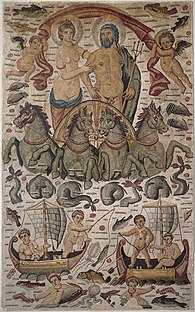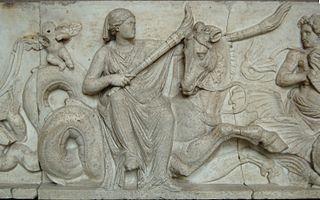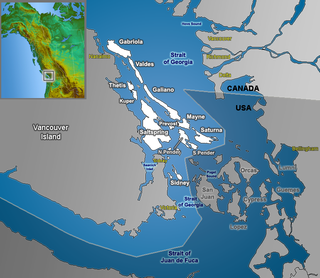
Thetis, is a figure from Greek mythology with varying mythological roles. She mainly appears as a sea nymph, a goddess of water, or one of the 50 Nereids, daughters of the ancient sea god Nereus.

Oceanus, also known as Ogenus or Ogen, was a divine figure in classical antiquity, believed by the ancient Greeks and Romans to be the divine personification of the ocean, which the Ancient Greeks perceived as an enormous river encircling the world.

In ancient Greek mythology, Amphitrite was a sea goddess and wife of Poseidon and the queen of the sea. She was a daughter of Doris and Nereus. Under the influence of the Olympian pantheon, she became the consort of Poseidon and was later used as a symbolic representation of the sea and the goddess of calm seas and safe passage through storms. It is said her voice is the only thing that can calm her husband’s mightiest of rages and lull him to a deep slumber so the ocean could be back at peace. In Roman mythology, the consort of Neptune, a comparatively minor figure, was Salacia, the goddess of saltwater.

In Greek mythology, Tethys, was a Titan daughter of Uranus and Gaia, sister and wife of the Titan Oceanus, mother of the river gods and the Oceanids. Tethys had no active role in Greek mythology and no established cults.

The Tethys Ocean, also called the Tethys Sea or the Neotethys, was an ocean during much of the Mesozoic Era located between the ancient continents of Gondwana and Laurasia, before the opening of the Indian and Atlantic oceans during the Cretaceous Period.

The Colour of Magic is a 1983 comic fantasy novel by Terry Pratchett, and is the first book of the Discworld series. The first printing of the British edition consisted of only 506 copies. Pratchett has described it as "an attempt to do for the classical fantasy universe what Blazing Saddles did for Westerns."
A troll is a mythological creature.
Trolls in Terry Pratchett's Discworld novels, unlike the monstrous trolls of folklore and J. R. R. Tolkien, have been subverted into a moderately civilised race. Trolls on the Discworld are, essentially, living, mobile rocks. Trolls have grown to overcome those vicious stereotypes of yore and have lived very prosperous lives in heavily populated cities with (relatively) little killing, and they have held jobs as diverse as police officer and concert promoter. They have also held jobs as "bridgekeepers", collecting tolls from those that cross their bridges. It is relatively harmless, although farmers in the company of billy goats have to pay a hefty toll.

The Thaliacea comprise a class of marine animals within the subphylum Tunicata. Unlike their benthic relatives the ascidians, thaliaceans are free-floating (pelagic) for their entire lifespan. The group includes species with complex life cycles with both solitary and colonial forms.
The ancient Greeks had numerous sea deities. The philosopher Plato once remarked that the Greek people were like frogs sitting around a pond—their many cities hugging close to the Mediterranean coastline from the Hellenic homeland to Asia Minor, Libya, Sicily and Southern Italy. Thus, they venerated a rich variety of aquatic divinities. The range of Greek sea gods of the classical era range from primordial powers and an Olympian on the one hand, to heroized mortals, chthonic nymphs, trickster-figures, and monsters on the other.

The Discworld is the fictional setting for all of Terry Pratchett's Discworld fantasy novels. It consists of a large disc resting on the backs of four huge elephants which are in turn standing on the back of an enormous turtle, named Great A'Tuin as it slowly swims through space. The Disc has been shown to be heavily influenced by magic and, while Pratchett has given it certain similarities to planet Earth, he has also created his own system of physics for it.

Doris, in Greek mythology, was a sea goddess, daughter of Oceanus and Tethys and wife of Nereus. By Nereus, she is mother to Nerites and the fifty Nereids, including Thetis and Amphitrite.
Thetis is a sea nymph in Greek mythology.

A salp or salpa is a barrel-shaped, planktic tunicate. It moves by contracting, thus pumping water through its gelatinous body, one of the most efficient examples of jet propulsion in the animal kingdom. The salp strains the pumped water through its internal feeding filters, feeding on phytoplankton.

Thetis Island is an island and unincorporated community off the coast of British Columbia, Canada, lying between Vancouver Island, which is to the west across Stuart Channel, and the west from the north tip of Galiano Island, from which it is separated by Trincomali Channel. With its immediate southern neighbour Penelakut Island, it is one of the Gulf Islands. Thetis island is 2,560 acres (1,036 ha) in size. It is approximately two miles wide and three miles long north to south. Two north to south land ridges define the east and west sides of the island. Burchell Hill is 591 metres above sea level, and forms the high point on the west side of Thetis island, and Moore Hill is 585 metres above sea level, and forms the high point ridge on the east side of the island.

"Troll Bridge" is a Discworld short story, written by Terry Pratchett in 1991 for a collection entitled After The King: Stories in Honour of J.R.R. Tolkien.
Eurynome was a deity of ancient Greek religion worshipped at a sanctuary near the confluence of rivers called the Neda and the Lymax in classical Peloponnesus. She was represented by a statue of what we would call a mermaid. Tradition, as reported by the Greek traveller, Pausanias, identified her with the Oceanid, or "daughter of Ocean", of Greek poetry.

Lake Thetis is a saline coastal lake in the mid-western region of Western Australia. The lake is situated east of the small town Cervantes, 2 kilometres (1.2 mi) inland from the Indian Ocean, on a Quaternary limestone pavement.

Eoacmaea is a genus of sea snails or true limpets, marine gastropod mollusks in the clade Patellogastropoda, the true limpets.















